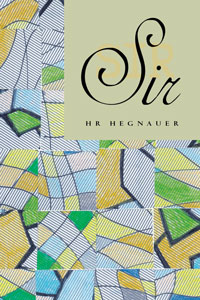Who is Sir? A pivot of language for an old man with a life of curious stories; a ghost, a mirage, a woman in Turkey. And a slice of the contemporary with its sickness, aging, death, its wars and commodities. HR Hegnauer has created an epistolary identity of engaged and hybridized increments from her own youthful living and details of others and their entwined poetries and presences. It is a highly performative text of depth, mind grammar, and beautiful gesture, inhabited by vivid characters and voices that change and charge the room. Bravo!
— Anne Waldman
AUTHOR STATEMENT:
I've been writing through what a memory can be and how to preserve it; how to keep it, lose it, and retrieve it again. SIR is an attempt at thinking about what it means to be a human alongside another human — how to grieve the loss of memory at the same time as the loss of life, while trying to keep in mind that we are living right now. I am indebted to my grandparents who have inspired the characters of Sir & Mrs. Alice.
Sir happens where the thresholds between the living, the dead, and the demented become progressively less clear. To remember that we are not above being human; that we are only humans trying to live amongst humans. I see this project as a form of archive. Of course, all writing is an archive, but to archive a story of dementia is inherently contradictory, and an archive of the ethereal is in some ways inconceivable. Then Sir asks the reader, can we archive the inconceivable contradictions? Will you try with me to not miss anything?
There are also underlying questions around the body’s relationship to gender, but to ask these questions are not the main purpose of the project. I have found, however, that it is unavoidable. I think of gender as a dead place, a failed place. And in part, I am writing an elegy towards gender.
During the writing of Sir, I would often ask myself Robert Gluck’s question What kind of representation least deforms its subject? I naturally come to a place of language, art, and media, but first, I come to this question in regards to my own human body. How might I represent myself so that I least deform my thoughts? Much of this project is concerned with dementia, and I believe that the form should attempt this idea, too. Some vignettes are long and clear while others are brief; when one story ends abruptly, it may be followed by something a decade later. I have been careful to not exploit these stories, yet at the same time, to not make them any more beautiful or desirable than as they exist. I want them to feel human, and of course, that is not always a desirable thing to be. But as Sir says to the narrator, Walk steady now, I’ve tried to place myself here as the author.
EXCERPT from SIR:
I cannot always remember what it is like to stand next to another human anymore. By this I mean, what it is like to stand next to every room in their body.
I like to drink my earl grey tea just after I’ve brushed my teeth because it tastes extra fresh like this — like it’s from the produce department or something. No one knows this anymore. Every year, I Photoshop my college ID to keep it current, and then I go to the opera where it makes my body feel both foreign and local at the same, and I like this contradiction. It’s the same way I feel when I write about how the word and is different from the word human. And I think that if everyone could just be a little more and, we’d all be a lot better off.
I want to know these things about another human.
The house that I’m now living in has a television, which is the first time I’ve lived with a television since I was in high school and lived at home. I’ve now learned from Oprah what forgiveness means. She said that to forgive someone means that you’ve realized you do not wish you were any different than you are right now. This does not mean that you must love what is to be forgiven… Or it went something like this… There were no colors. This never happened.
I understand now that this is what happens when a human tries to become an and: the language won’t let us.
I’m writing these stories in reverse now because I can’t remember how to emit time anymore. I wanted to curse Sir. Don’t you know she’s got no memory!? But the one from sixty years ago is like a glass of water only even more clear: it doesn’t even have that distorted part at the lip: the part where you can’t tell how tall something is. The problem is is that her sentences have to exist right now. This is what the limit of her body is.
Sometimes I think about what it is like to live in Colorado now for the first time in three generations, and I wonder if the memory of the body might be genetic.
Mrs. Alice, what are the limits of the body?
This is… This is…
And then that was it. It was like she had forgotten how to make a sentence anymore. This is what? What is this? Or was it, This is, period. I’m so afraid of this. I want to make these sentences. And I want to make them sixty years from now, too.
I work most days as a book designer, and two nights ago, I was working on a text about phenomena when I noticed that something strange was happening with the letters. I zoomed in and in and more and again. I saw each letter up closely, and I saw that they were breathing — literally and slowly. Maybe you don’t believe me, but I saw this vividly. It was like the letters were made of tiny humans lying on their backs with their arms crossed over their chests. They looked something like miniature living corpses on their deathbeds. It seemed that they might be suffocating one another — being so closely piled. So I gave space around each letter and word and line and margin, and then I zoomed back in and in and more closely still, and again, and they had stopped. Entirely. There was no more breathing — not even slowly, not even a little.
From inside of my dream, Sir asked me if I was dreaming. I said, I don’t think so. He said, you know, this is where the word goes when it’s ready to die. It goes inside the book, and it holds itself here.
The next morning, I got a phone call that the author had died.
Dear Sir,
Can I still write you little letters even though you’re dead now?
Please say yes.
BIO:
HR Hegnauer is a book designer and website designer specializing in working with independent publishers as well as individual artists and writers. She is a member of the feminist publishing collaborative Belladonna*, and she’s part of the poets’ theater group GASP: Girls Assembling Something Perpetual. HR received her MFA in Writing & Poetics from Naropa University, where she has also taught in the Summer Writing Program. Sir is her first book. |
 |

